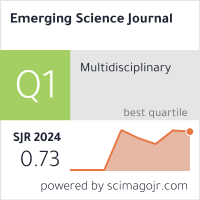Empirical Analysis of Executive Capital, Innovation, and Risk-Taking in A-Share Tech Firms
Downloads
This research aims to explore the impact of executive human capital (SMHC) on the performance of Chinese A-share technology listed companies, with a focus on the mediating roles of technological innovation and risk-taking. Using 13,733 data points from 2,796 A-share technology listed companies from 2014 to 2022 sourced from the CSMAR Database, the OLS regression method was employed for analysis. The research findings indicate that SMHC, including its stock, flow, and investment, significantly improves enterprise performance. Among them, investment has the most significant impact, enhancing both economic benefits and market value. Moreover, technological innovation and risk-taking play mediating roles, with positive and significant coefficients. This research enriches the understanding of the relationship between SMHC, technological innovation, risk-taking, and enterprise performance, providing new insights for enterprises to optimize their human capital management and enhance competitiveness.
Downloads
[1] Ganapathy, V. (2019). Strategic Management of Human Capital. Journal of Chemical Information and Modeling, 17, 1-15.
[2] Zahra, S. A., Nash, S., & Bickford, D. J. (1995). Transforming technological pioneering into competitive advantage. Academy of Management Perspectives, 9(1), 17-31. doi:10.5465/ame.1995.9503133481.
[3] Settembre-Blundo, D., González-Sánchez, R., Medina-Salgado, S., & García-Muiña, F. E. (2021). Flexibility and resilience in corporate decision making: a new sustainability-based risk management system in uncertain times. Global Journal of Flexible Systems Management, 22(Suppl 2), 107-132. doi:10.1007/s40171-021-00277-7.
[4] Li, W., Peng, Y., Yang, J., & Sazzad Hossain, M. (2024). Human Capital Structure and Innovation Efficiency Under Technological Progress: Evidence from China. SAGE Open, 14(3), 21582440241277165. doi:10.1177/21582440241277165.
[5] Wang, C. Y. P., Jaw, B. S., & Tsai, C. H. C. (2012). Building dynamic strategic capabilities: a human capital perspective. The International Journal of Human Resource Management, 23(6), 1129-1157. doi:10.1080/09585192.2011.561234.
[6] Wu, S. H., Lin, F. J., & Perng, C. (2022). The affecting factors of small and medium enterprise performance. Journal of Business Research, 143, 94-104. doi:10.1016/j.jbusres.2022.01.025.
[7] Berman, S. J., Davidson, S., Ikeda, K., Korsten, P. J., & Marshall, A. (2016). How successful firms guide innovation: insights and strategies of leading CEOs. Strategy & Leadership, 44(5), 21-28. doi:10.1108/SL-07-2016-0062.
[8] Zhang, Y., Muharam, F. M., & Wu, X. (2024). Integrating Top Management’s Intellectual Capital with Technology Innovation Performance of High-Tech Enterprises: A Conceptual Study. International Journal of Academic Research in Business and Social Sciences, 14(12). doi:10.6007/ijarbss/v14-i12/24087.
[9] Nasirov, S., Li, Q. C., & Kor, Y. Y. (2021). Converting technological inventions into new products: The role of CEO human capital. Journal of Product Innovation Management, 38(5), 522–547. doi:10.1111/jpim.12601.
[10] Kurzhals, C., Graf-Vlachy, L., & König, A. (2020). Strategic leadership and technological innovation: A comprehensive review and research agenda. Corporate Governance: An International Review, 28(6), 437–464. doi:10.1111/corg.12351.
[11] Cao, D., & Yu, Y. (2023). Top management team stability and enterprise innovation: A chairman’s implicit human capital perspective. Managerial and Decision Economics, 44(4), 2346–2365. doi:10.1002/mde.3821.
[12] Du, M., Wang, H., & Tan, Q. (2023). Top management team social capital, digital technology and enterprise innovation performance. Technology Analysis and Strategic Management, 37(1), 82–95. doi:10.1080/09537325.2023.2282067.
[13] Ingley, C., & Van Der Walt, N. (2008). Risk management and board effectiveness. International Studies of Management & Organization, 38(3), 43-70. doi:10.2753/IMO0020-8825380302.
[14] Zhang, H., & Zhu, Y. (2024). Financial knowledge, executive decision making and enterprise innovation. Finance Research Letters, 61, 104925. doi:10.1016/j.frl.2023.104925.
[15] Pan, Y., Siegel, S., & Wang, T. Y. (2017). Corporate risk culture. Journal of Financial and Quantitative Analysis, 52(6), 2327-2367. doi:10.1017/S0022109017000771.
[16] Duan, Y., Deng, Z., Liu, H., Yang, M., Liu, M., & Wang, X. (2022). Exploring the mediating effect of managerial ability on knowledge diversity and innovation performance in reverse cross-border M&As: Evidence from Chinese manufacturing corporations. International Journal of Production Economics, 247, 108434. doi:10.1016/j.ijpe.2022.108434.
[17] George, G., Zahra, S. A., & Wood Jr, D. R. (2002). The effects of business–university alliances on innovative output and financial performance: a study of publicly traded biotechnology companies. Journal of business Venturing, 17(6), 577-609. doi:10.1016/S0883-9026(01)00069-6.
[18] Hu, B., Yang, W., Zhang, S., Yan, S., & Xiang, Y. (2024). Linking the top management team transactive memory system, strategic flexibility and digital business model innovation: a dynamic capabilities perspective. Technology Analysis & Strategic Management, 1-13. doi:10.1080/09537325.2024.2321302.
[19] Zhong, C., Huang, R., Duan, Y., Sunguo, T., & Dello Strologo, A. (2024). Exploring the impacts of knowledge recombination on firms’ breakthrough innovation: The moderating effect of environmental dynamism. Journal of knowledge management, 28(3), 698-723. doi:10.1108/JKM-08-2022-0623.
[20] Ma, C., Ge, Y., & Wang, J. (2021). Top management team intrapersonal functional diversity and adaptive firm performance: The moderating roles of the CEO–TMT power gap and severity of threat. Frontiers in psychology, 12, 772739. doi:10.3389/fpsyg.2021.772739.
[21] Vega Jurado, J. M., Sánchez-Mojica, K. Y., Paternina-Arboleda, C. D., & Manjarrés-Henriquez, L. (2022). Determinants of open innovation in low-tech SMEs: the influence of the top management team and employees’ human capital. Journal of Technology Management & Innovation, 17(1), 3–14. doi:10.4067/s0718-27242022000100003.
[22] Braunerhjelm, P., & Lappi, E. (2023). Employees’ entrepreneurial human capital and firm performance. Research Policy, 52(2), 102 – 255. doi:10.1016/j.respol.2022.104703.
[23] Choi, I., Chung, S., Han, K., & Pinsonneault, A. (2021). CEO Risk-Taking Incentives and IT Innovation: The Moderating Role of a CEO’s IT-Related Human Capital. MIS Quarterly: Management Information Systems, 45(4), 2175–2192. doi:10.25300/MISQ/2022/15606.
[24] Tahir, S. H., Ullah, M. R., Ahmad, G., Syed, N., & Qadir, A. (2021). Women in top management: Performance of firms and open innovation. Journal of Open Innovation: Technology, Market, and Complexity, 7(1), 87. doi:10.3390/JOITMC7010087.
[25] Hanushek, E. A., Kinne, L., Lergetporer, P., & Woessmann, L. (2022). Patience, Risk-Taking, and Human Capital Investment Across Countries. Economic Journal, 132(646), 2290–2307. doi:10.1093/ej/ueab105.
[26] Atayah, O. F., Najaf, K., Subramaniam, R. K., & Chin, P. N. (2022). The ascension of executives’ tenure, corporate risk-taking and corporate performance: evidence from Malaysia. Asia-Pacific Journal of Business Administration, 14(1), 101–123. doi:10.1108/APJBA-05-2021-0189.
[27] Teodósio, J., Vieira, E., & Madaleno, M. (2021). Gender diversity and corporate risk-taking: a literature review. Managerial Finance, 47(7), 1038–1073. doi:10.1108/MF-11-2019-0555.
[28] García-Lopera, F., Santos-Jaén, J. M., Palacios-Manzano, M., & Ruiz-Palomo, D. (2022). Exploring the effect of professionalization, risk-taking and technological innovation on business performance. PLoS ONE, 17(2), 0263694. doi:10.1371/journal.pone.0263694.
[29] Xue, S., Zhang, B., & Zhao, X. (2021). Brain drain: The impact of air pollution on firm performance. Journal of Environmental Economics and Management, 110. doi:10.1016/j.jeem.2021.102546.
[30] Andersén, J. (2021). Resource orchestration of firm-specific human capital and firm performance—the role of collaborative human resource management and entrepreneurial orientation. International Journal of Human Resource Management, 32(10), 2091–2123. doi:10.1080/09585192.2019.1579250.
[31] Chen, M. Y. C., Lam, L. W., & Zhu, J. N. Y. (2020). Should companies invest in human resource development practices? The role of intellectual capital and organizational performance improvements. Personnel Review, 50(2), 460-477. doi:10.1108/PR-04-2019-0179.
[32] Samad, S. (2020). Achieving innovative firm performance through human capital and the effect of social capital. Management and Marketing, 15(2), 326–344. doi:10.2478/mmcks-2020-0019.
[33] Tran, N. P., & Vo, D. H. (2020). Human capital efficiency and firm performance across sectors in an emerging market. Cogent Business and Management, 7(1). doi:10.1080/23311975.2020.1738832.
[34] Ren, S., Jiang, K., & Tang, G. (2022). Leveraging green HRM for firm performance: The joint effects of CEO environmental belief and external pollution severity and the mediating role of employee environmental commitment. Human Resource Management, 61(1), 75–90. doi:10.1002/hrm.22079.
- This work (including HTML and PDF Files) is licensed under a Creative Commons Attribution 4.0 International License.




















